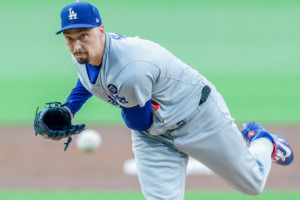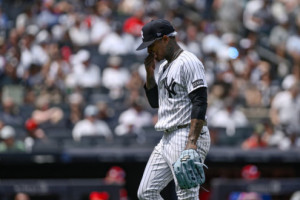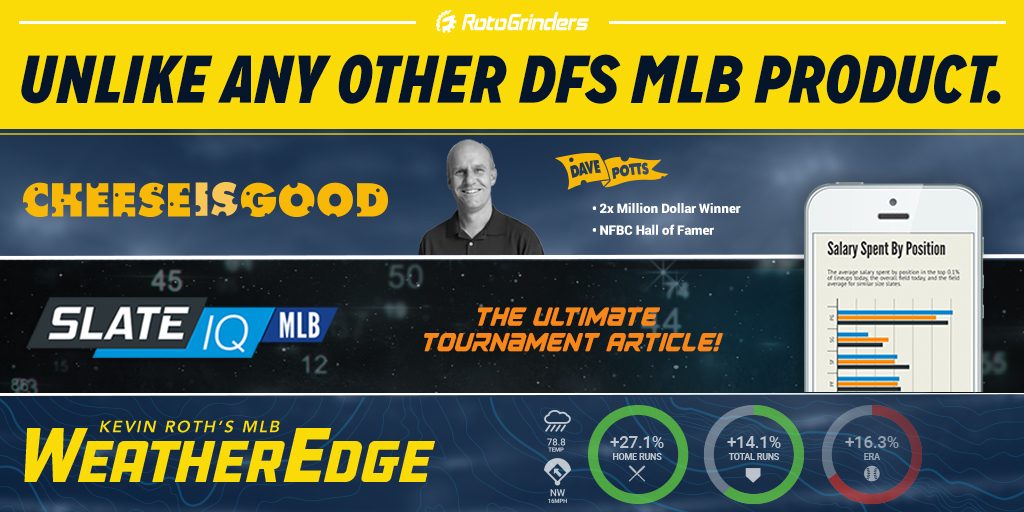10 Definitely Interesting, Possibly Helpful MLB Notes for Tuesday, April 2nd
Welcome to 10 Definitely Interesting, Possibly Helpful Notes! In this column, I’ll work to uncover some interesting bits of information that might shed some light on players from that day’s slate of MLB games. This is not a picks column, nor is it a “fun facts” article – it’s something in between.
I hope you enjoy it, and I hope it helps you think about today’s MLB plays in a new way as you build your DFS lineups. Here are 10 Notes for Tuesday, April 2nd.
1. Justin Verlander has played 420 games in MLB dating back to 2005. The 20.6% swinging strike rate he earned in his Opening Day start (a seven-inning, seven-strikeout gem with the only earned run coming off an Austin Meadows solo shot) was the third-highest mark in of all those starts. In fact, he’s posted swinging-strike rates better than 20 percent in six games over the course of his career, and all six of these games have come during his stint in Houston. Maybe it’s the supermodel wife, maybe it’s the Flonase keeping those seasonal allergies at bay; whatever it is, Verlander is defying aging curves by racking up more K’s than ever as he enters what, for ordinary human beings, would be the twilight of a long career. Tuesday is a slate packed with aces, but Verlander offers the best combination of strikeout upside and matchup. He should be able to take advantage of a Rangers offense that comes pre-packaged with strikeouts (five of Texas’s projected lineup have K rates north of 22 percent), making him arguably the top overall pitcher (Scherzer’s there, as well) on a crowded slate for aces.
2. Blake Snell threw 37.4% curveballs in his first start; that’s an increase of nearly 17 percentage points off last year’s mark (20.2%). It feels like an impossible task for Snell to top his Cy Young campaign of a year ago, but if he’s going to try, throwing his elite Uncle Charlie more often may be one way of staving off regression. Since 2018, Snell’s curve has an xwOBA of .151, second-best in MLB, behind only Verlander’s offering. (Yes, Snell did allow three hits including a home run on the curve in his last start, but we can comfortably chalk that up to small sample). Apart from a nice matchup against the Road Rockies (whose 87 wRC+ away from Coors ranked 29th last year, just behind the Baltimore Orioles…yeah, the freaking Orioles), the real selling point for Snell is his price tag. At DraftKings, he’s $2,300 cheaper than Justin Verlander. $2,300! On a slate with more must-have bats, there’d be a legitimate case for fading the top three (Scherzer, Verlander, Sale) and plugging in Snell as an SP1. As it stands, he’s a bargain-priced arm who should have no trouble rebounding off of a shaky Opening Day start.

3. Marcus Stroman got 16 swings and misses in his first start of the year; that’s the second-most of any start of his career. We could reasonably chalk that up to a fluke. But it may not be. In that start, Stroman seemed to realize it’s 2019 and all pitchers strike everyone out in 2019. He added more sliders to his mix (35.1%, up from 29.9% in 2018), a move many pitchers are making nowadays, with positive results. The sinker will always be Stroman’s first love, and we have no idea if the increased slider usage will stick. But for today, Stroman is a high-floor option in a pristine matchup against an Orioles offense that is so bad they get ridiculed in notes that have nothing to do with them (see Note 2 above).
4. Earned runs allowed by Hyun-Jin Ryu in his last 10 starts in his home park of Dodgers Stadium: 1, 0, 0, 1, 2, 1, 3, 0, 0, 0. Ryu has been a beast at home, and on Tuesday, he’s in a best-case-scenario matchup San Francisco Giants, who already feel like last year’s Padres, a team worth picking on nearly every game. At $9,300 at DraftKings, Ryu occupies the weird middle ground between the elite aces and the trash at the bottom of the pitcher pool (obligatory reminder: Andrew Cashner was once traded for Anthony Rizzo…). The issue with Dodgers pitchers, as always, is whether they can make efficient use of the 80 or so pitches they’ll be allowed to throw (Ryu was pulled at 82 pitches in his first start). Ryu still has a great shot of reaching value given the matchup and his ever-improving stuff, which puts him squarely in play in tournaments.
5. Tommy Pham has now reached base in 37 consecutive games dating back to last season; that’s the longest active streak in MLB and just one off the Rays franchise record set by Johnny Damon in 2011. Since the beginning of Pham’s streak (August 21), he ranks third in MLB in hard hits (53.6%), third in wRC+ (210), and third in OPS (1.138). It’s very hard to find a metric wherein Pham has been anything but a top-three or -four hitter in MLB since that date. Kyle Freeland is a master at generating weak contact, but outside of a few obvious spots (Astros, Blue Jays), we’ll be scrounging for decent hitter matchups on Tuesday given the slew of aces taking the hill. Pham’s combination of contact skills, power, and steals makes him an intriguing tournament option who can put up points in a bunch of different ways.

6. I’ve got a joke: What do you get when you take Billy Hamilton and add 150 points of on-base percentage? Mallex Smith, who, after the All-Star break last year, posted a .390 OBP to go along with 24 steals. He went about it quietly, but it was a rare feat: The last player to post a .390 OBP while swiping 24 in the second half was Juan Pierre in 2004, and before him, Rafael Furcal in 2000. He’s an on-base machine, he loves to run, he bats leadoff, he’s got the platoon edge against Trevor Cahil, and he’s moderately priced ($4,100 at DraftKings). I can’t think of a good reason to just throw him in a cash game lineup.
7. Speaking of players who surged in the second half last season, let’s take a look at Michael Conforto’s isolated power, HR/FB rate, and hard-hit rate before and after the break in 2018:
1st half – .150 ISO, 14.3% HR/FB, 33.5% hard hits
2nd half – .266 ISO, 26.2% HR/FB, 38.4% hard hits
It’s not totally an arbitrary endpoint thing, either; Conforto was recovering from shoulder surgery to start the year,so it’s reasonable to assume he was still regaining his power in the first part of the year. People aren’t going to play Michael Conforto given that he’s playing in cavernous Marlins Park, but let’s not forget that Conforto has played half his career games at CitiField was just a smidge better for hitters in that regard (91 park factor for lefty HRs in 2018, per Baseball Prospectus, compared to a 90 for Marlins Park). It also doesn’t hurt that Marlins starter Jose Urena has long had issues with left-handed power bats, surrendering 1.32 HR/9 or higher in all four of his big-league seasons. There are certainly better point-per-dollar plays out there today, but Conforto fits the bill as an enticing (and likely low-owned) GPP play.
8. Eddie Rosario has a .336 average against ground ball pitchers since 2016; that’s tied for the eighth-best mark in MLB over that span (min. 200 AB). It’s a small enough sample that we may not want to put too much stock in it, but (and this is becoming a them) it’s really tricky to find great bats on Tuesday’s slate. One more positive note on Rosario: He’s really worked on making more contact over the years, all the while adding power, so much so that he’s got a .202 ISO and a 17.9% K rate since 2016. Only 14 other players can say that. Brad Keller certainly doesn’t represent an ideal matchup, but Rosario’s ability to make good contact low in the zone makes him a sneaky play.
9. Here’s the complete list of players with .237 ISO and a sub-17.0% strikeout rate against left-handed pitching since 2017 (min. 300 PA): Mookie Betts, Nolan Arenado, Justin Turner, A.J. Pollock, Manny Machado, Alex Bregman, and … Kike Hernandez. Hernandez improved against righties in 2018, but his ability to excel with the platoon advantage has never left him. On Tuesday, he should be hitting atop the Dodgers’ lineup against Madison Bumgarner in what is a BvP Truthers’ dream and Derek Carty’s Nightmare: Hernandez is a career 14-for-29 with three homers (and a 1.397 OPS!) against Bumgarner. As with every bat I’ve listed here, it’s far from a perfect matchup (BvP aside), as Bumgarner looked excellent in his first start of 2019. Hernandez’s price makes the matchup a bit more palatable, though. Fire him up.
10. It’s time to play blind resume! Below, you’ll find the numbers for two batters, both left-handed, against right-handed pitching since the start of 2018:
| Stat | Player A | Player B |
|---|---|---|
| PA | 486 | 283 |
| wOBA | .378 | .362 |
| ISO | .184 | .182 |
| wRC+ | 136 | 133 |
Very similar overall production against righties, as you’ve noticed. Player A is Freddie Freeman, “Free Money Freddie,” one of the steadier first base options in MLB DFS. Player B is far less heralded, but he’s had nearly as much success against opposite-handed pitchers…
It’s new Mariners catcher Omar Narvaez. You can quibble with the sample size, and sure, if Narvaez had 200 more plate appearances, the numbers might decline a bit. But his combination of on-base skills and decent power (especially at the catcher position), along with the fact that he’s continually underpriced at DraftKings ($3,300 on Tuesday) means he’ll continue to find a spot in my cash game lineups.
__________________________________________________________________________________________________________________________________
Thanks for reading! Stats from this article were pulled from RotoGrinders’ PlateIQ tool, FanGraphs, Baseball Savant, Brooks Baseball, Baseball Prospectus, and Baseball Reference.
Check back for more “10 Notes” MLB articles throughout the year, and feel free to leave a question or comment down below!
